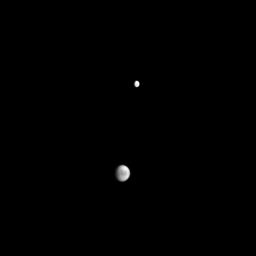
|
Two Moons, One Picture
- Click the image above for a larger view
- Full-Res JPEG (604 x 604) (5.1 kB)
- Full-Res TIFF (604 x 604) (365.4 kB)
Caption:
The orbits of Dione and Titan bring them together in one frame in this distant glimpse from the Cassini spacecraft.
Light and dark areas on Dione (1123 kilometers, or 698 miles across), at the top of the frame, hint at that moon's fractured surface. Through the hazy atmosphere of Titan (5150 kilometers, or 3200 miles across) at the bottom, the dark region of Senkyo is visible.
This view looks toward the Saturn-facing side of Titan and the leading hemisphere of Dione. North on Titan is up and rotated 3 degrees to the left. The image was taken with the Cassini spacecraft wide-angle camera on Jan. 28, 2009 using a spectral filter sensitive to wavelengths of near-infrared light centered at 939 nanometers.
The view was acquired at a distance of approximately 2.3 million kilometers (1.4 million miles) from Titan and at a Sun-Titan-spacecraft, or phase, angle of 44 degrees. Image scale is 140 kilometers (87 miles) per pixel.
Background Info:
The Cassini-Huygens mission is a cooperative project of NASA, the European Space Agency and the Italian Space Agency. The Jet Propulsion Laboratory, a division of the California Institute of Technology in Pasadena, manages the mission for NASA's Science Mission Directorate, Washington, D.C. The Cassini orbiter and its two onboard cameras were designed, developed and assembled at JPL. The imaging operations center is based at the Space Science Institute in Boulder, Colo.
For more information about the Cassini-Huygens mission visit http://saturn.jpl.nasa.gov/ . The Cassini imaging team homepage is at http://ciclops.org .
Cataloging Keywords:
| Name | Value | Additional Values |
|---|---|---|
| Target | Titan | Dione, Saturn |
| System | Saturn | |
| Target Type | Satellite | Planet |
| Mission | Cassini-Huygens | |
| Instrument Host | Cassini Orbiter | |
| Host Type | Orbiter | |
| Instrument | Imaging Science Subsystem (ISS) | |
| Detector | Wide Angle Camera | |
| Extra Keywords | Atmosphere, Grayscale, Haze, Infrared, Rotation, Visual | |
| Acquisition Date | ||
| Release Date | 2009-04-03 | |
| Date in Caption | 2009-01-28 | |
| Image Credit | NASA/JPL/Space Science Institute | |
| Source | photojournal.jpl.nasa.gov/catalog/PIA11463 | |
| Identifier | PIA11463 | |
